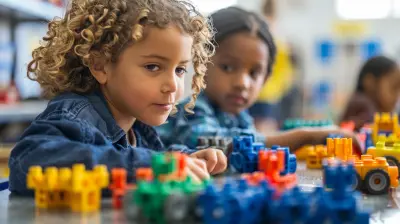22 April 2025
Oh, the joys of education! Where teachers pour their hearts out, students stare blankly at the walls, and group projects turn into one kid doing all the work while the rest "supervise." If only there were a way to get students to think for themselves, right?
Well, spoiler alert: there is! Encouraging independent problem-solving in the classroom isn't just possible—it's necessary. And no, I’m not talking about just throwing a tough math problem at them and hoping for the best. We’re going beyond that. Buckle up because we’re about to break down how to turn students into critical thinkers instead of human parrots who simply regurgitate whatever’s in the textbook. 
Why Encouraging Independent Problem Solving Matters
Let's face it—life isn't a multiple-choice test (unless you're in a game show, in which case, lucky you). The real world demands creativity, adaptability, and, most importantly, the ability to solve problems without Google-saving-the-day every five seconds. Teaching kids how to figure things out on their own? That's like giving them a cheat code for life (except it's totally legal).When students develop independent problem-solving skills, they:
- Build confidence in their abilities
- Become more resilient in the face of challenges (aka they stop giving up after two seconds)
- Learn how to think critically instead of memorizing random facts
- Stop depending on teachers for answers to every single question (hallelujah!)
Sounds like a dream, right? Now, let’s dig into how to actually make this happen. 
1. Stop Spoon-Feeding Answers
Ever had a student ask, "Is this the right answer?" before even attempting the problem? Yeah, same.Teachers, we have to stop swooping in like superheroes with all the answers. It’s tempting, I know. You want them to succeed. But by constantly giving students the answers, we’re basically training them to be dependent on us. Instead, try this:
- Respond with another question instead of an immediate answer.
- Encourage students to explain their thinking before you step in.
- Act clueless sometimes—let them teach YOU (trust me, they love doing this).
The goal is to shift the focus from finding answers to understanding processes. Because in the grand scheme of things, knowing how to solve a problem is way more important than temporarily memorizing an answer. 
2. Create a Trial-and-Error Friendly Environment
Wouldn't it be nice if failure wasn’t seen as the end of the world? In most classrooms, mistakes are treated like contagious diseases—avoid them at all costs. But in reality, failure is just part of the learning process.Encourage students to try, fail, and try again without feeling like they’ve just ruined their entire lives. How?
- Normalize mistakes—share stories of your own failures.
- Celebrate effort, not just perfection.
- Introduce "fail-forward" activities where mistakes are required to move on.
When students stop being afraid of getting things "wrong," they start actually figuring things out. Pretty neat, huh? 
3. Teach the Art of Questioning
Ever met a kid who asks "Why?" five million times a day? Annoying? Yes. But also, that’s exactly the mindset we want to encourage.Independent thinkers ask questions. They question assumptions, processes, and even answers. So, let’s help them develop strong, meaningful questions instead of just memorizing what’s in the textbook.
Try this:
- Teach them the difference between open-ended and closed questions.
- Encourage them to ask "What if?" and "How come?" more often.
- Give them real-world problems where they need to develop their own questions before jumping into solutions.
The more they learn to question things, the more they’ll take charge of their own learning.
4. Use Real-World Problems (Because, You Know, Those Actually Matter)
If students constantly ask, "When will I ever use this in real life?"—congratulations! You’ve just been called out.Let’s be real. Students are way more interested in figuring out how to go viral on social media than solving some hypothetical math problem about trains traveling at different speeds. So why not make problem-solving exercises about things they actually care about?
- Let them solve real-world problems (financial budgeting, environmental issues, social conflicts, etc.).
- Use case studies that connect to their interests.
- Incorporate problem-based learning where they have to research and propose solutions.
When students see the relevance, they engage. When they engage, they actually think. And when they think, they become independent problem solvers. Boom.
5. Encourage Peer Collaboration (But in a Non-Cheating Kind of Way)
Independent problem-solving doesn’t mean doing everything alone. In the real world, we collaborate, brainstorm, and build off each other’s ideas. The key is to create an environment where students work together without just copying answers off each other’s papers.Here’s how:
- Use structured group work where each student has a role.
- Encourage peer-to-peer teaching.
- Have students debate solutions before settling on one.
The goal is for students to challenge each other’s thinking, not just sit back and let the "smart kid" do all the work.
6. Gamify Problem Solving
Let’s be honest—students will do anything if it’s turned into a game. Why not take advantage of that?Gamification makes problem-solving fun, engaging, and slightly addictive (in a good way). Whether it’s through classroom escape rooms, challenge-based rewards, or interactive puzzles, students are more likely to want to solve problems if there's an element of play involved.
Try:
- Escape room challenges where students solve clues to "break out."
- Interactive math or logic puzzles.
- Reward-based systems where they earn points for creative solutions.
Gamification not only increases motivation but also makes learning feel less like a chore and more like an adventure.
7. Model Problem-Solving Skills
News flash: Students are watching everything you do. (Creepy, I know.) But this is actually a good thing because it means they’ll learn problem-solving just by seeing you do it.Next time you encounter a tricky situation in class, think out loud. Walk through your reasoning process. Show them what it looks like to approach a problem step by step.
- Break problems into small, manageable parts.
- Demonstrate multiple ways to tackle a problem.
- Admit when you don’t know something—and model how to figure it out.
When they see you actively solving problems, they’ll start to mimic that behavior.
8. Give Them Ownership Over Their Learning
Lastly, let’s loosen the reins a bit. If students never have control over their learning, they’ll never take full responsibility for it.Give them choices—lots of choices.
- Let them choose how they present their solutions.
- Allow them to decide which problems they want to tackle first.
- Give them independent projects where they can explore topics they’re passionate about.
The more ownership they have, the more invested they’ll be. And an invested student? That’s a problem-solving powerhouse.
Final Thoughts
Encouraging independent problem-solving in the classroom isn’t about abandoning students to figure things out on their own. It’s about creating an environment where they feel confident enough to think critically, push through challenges, and come up with their own solutions.So, teachers, let’s stop handing out all the answers like free candy. Instead, let’s cultivate a generation of thinkers, innovators, and problem-solvers. Who knows? Maybe one of them will even figure out how to make grading papers less painful. (We can dream.




Rosalie Elliott
This article highlights the importance of fostering independent problem-solving skills in students. By creating a supportive environment that encourages exploration and critical thinking, educators can empower learners to tackle challenges confidently. Implementing strategies like collaborative learning and open-ended questions can significantly enhance students' ability to think creatively and independently.
April 23, 2025 at 4:02 AM